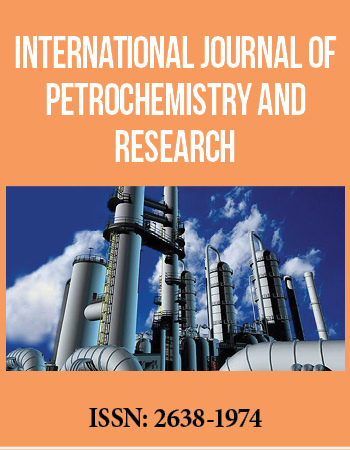Case Report
Unconventional Gas is the Fuel of the Future for Jordan
Petroleum Engineering Department, Abu Dhabi Polytechnic, Abu Dhabi, UAE
*Corresponding author: Abdelaziz Lafi Khlaifat, Petroleum Engineering Department, Abu Dhabi Polytechnic, Abu Dhabi, UAE, E-mail: abdelaziz.khlaifat@adpoly.ac.ae
Received: May 15, 2017 Accepted: June 14, 2017 Published: June 21, 2017
Citation: Khlaifat AL. Unconventional Gas is the Fuel of the Future for Jordan. Int J Petrochem Res. 2017; 1(2): 79-86. 10.18689/ijpr-1000114
Copyright: © 2017 The Author(s). This work is licensed under a Creative Commons Attribution 4.0 International License, which permits unrestricted use, distribution, and reproduction in any medium, provided the original work is properly cited.
Abstract
Comparable to conventional hydrocarbon systems, unconventional gas reservoirs are characterized by complex geological and petrophysical systems as well as heterogeneities at all scales. Unlike conventional reservoirs, unconventional gas reservoirs exhibit unique gas storage capacity and exceptional producing characteristics. Unconventional gas resources (tight and shale gas) are now a core business of many large gas producers compared to being an emerging source two decades ago. This is due to the significant improvement in understanding of these resources and advancement in technology used to target unconventional resources. Also, cost and operating efficiencies allow aggressive commercial development of such gas plays.
This paper focuses on unconventional gas development, resources, basin-centered gas accumulations, comparison between conventional and unconventional resources, challenges facing unconventional reservoirs development. Case histories of tight and shale gas plays in Jordan are discussed.
Keywords: conventional reservoirs; coalbed methane; shale gas; natural gas
Introduction
The International Energy Agency (IEA) predicted that oil supplies could rise as high
as 120m barrels a day by 2030 [1]. The 120m figure is debatable and can be influenced
by too many unseen factors. According to IEA there is a clear decline of 'currently
producing fields', the clear oil peak took place right about 2004-2008, after which a
massive increase in 'fields yet to be developed' followed by another big portion of 'fields
yet to be found.' An increase in 'non-conventional oil' and 'natural gas liquids'
encompasses out the supply picture to meet the 120m figure. Based on this scenario the
global oil production in total is not expected to peak before 2030, production of
conventional oil - crude oil is projected to level off and become steady within the coming
couple of years. Conventional crude oil production alone increases only modestly over
2010-2030 – by a bit less than 5 mb/d - as almost all the additional capacity from new
oilfields is offset by declines in output at existing fields.
The bulk of the net increase in total oil production comes from NGLs (driven by the
relatively rapid expansion in gas supply) and from unconventional resources and
technologies. Unconventional resources/reservoirs are defined as: tight gas; heavy oil; shale gas; gas hydrate and coalbed methane reservoirs. These resources became a core
business of many large producers and a growing number of the majors.
A tight gas reservoir is one that cannot be produced at economic flow rates or
recover economic volumes of gas unless the well is stimulated by a large hydraulic
fracture treatment and/or produced using horizontal wellbores [2] [3]. This definition
also applies to coalbed methane, shale gas, and tight carbonate reservoirs. There is no
typical tight gas reservoir, it can be: deep or shallow; high pressure or low pressure; high
temperature or low temperature; homogeneous or naturally fractured (heterogeneous); single or multilayered; high transient decline rates; comingled production; require fracturing jobs and/or horizontal well. In other words, tight
gas is gas that is 'trapped' in a very tight formation
underground, stored within low porosity and low permeability
rock formations. A great deal of effort has to be put into
extracting this gas from a tight formation, such as fracturing
and acidizing.
In many basins, e.g. Rocky Mountain basins in the Western
US, gas accumulations in low permeability sandstones are
associated with widespread gas shows while drilling and a lack
of associated water production where the productivity of
wells drilled in these settings varied dramatically [4]. This
suggested having localized areas with more favorable rock
properties, sweet spots, or the variations in drilling and
completion technology account for the productivity variability.
Tight Gas Sands Development
The development of many tight gas sand fields that are
productive today began in the Western United States San
Juan Basin. By 1970s, around 1 Tcf/year were produced
nationwide from the TGS. Then different fields were discovered
including fields in East Texas (Dew-Mimms Creek), the
Piceance Basin of northwestern Colorado (Rulison, Mamm
Creek), the Green River Basin of Wyoming (Jonah, Pinedale, Wamsutter), and the Denver-Julesberg Basin of Colorado (Wattenberg). Tight gas is predominantly a cost-effective
issue. Production is relative to technology development, well
cost, stimulation cost and existing gas price. As technology
has developed, the permeability threshold in North America
has changed from less than 0.1mD in the 1970s to less than
0.01mD in the 1980s to less than 0.001mD (ultra-tight) today
[2] [4] [5] [6]. As a result, tight gas now makes a substantial
contribution (about 30% of produced gas) to USA gas supply. This figure was obtained based on the 70% contribution of
unconventional gas that accounts for 43% of the USA gas
production. The technologies that have allowed this are the
ability to drill long horizontal wells, effective fracture
stimulation and reservoir characterization including
developments in 3D seismic, special core analysis, electric log
data, and diagenetic and structural analysis.
In Europe, the higher cost base and ready access to
"cheap" imported gas means that tight gas development has
been largely neglected, except in Germany where financial
incentives for tight gas exist. In Germany, tight reservoirs
include reservoirs with effective gas permeability less than 0.6
mD [7]. The potential resources of undiscovered and tight gas
in Germany are in the range of 50 to 150 billion cubic meters. Tight gas developments are currently underway in Germany, offshore Holland and the UK, and efforts are being made to
develop basin centered gas accumulations in Central Europe. Unconventional gas extracted from European territory is not
expected to come to market for at least a decade.
Recent developments in the gas sector caused by the
application of new technology have made unconventional
gas resources available at competitive cost. A boom in
unconventional gas would also have considerable implications for different countries' energy policy. Unconventional gas can
play significant role in transforming any country's energy
supply situation, but this is accompanied by an extra cost of
addressing the technological and economic challenges
unconventional gas faces as well as the questions of public
acceptance.
Resources
The world natural gas reserves by geographic region are
shown in Figure 1 [8]. From this figure one can see that the
largest resources of natural gas exist in the Middle East.
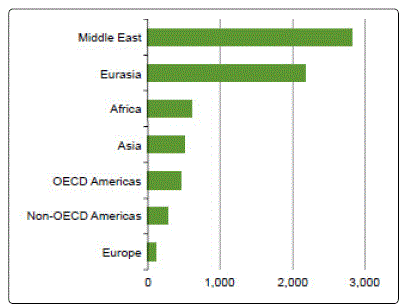
Figure 1. World Proved Natural Gas Reserves by Region as of January 1, 2016 (trillion cubic feet: Tcf)
The total scope of gas resources was viewed as a triangle
for the first time by Master [9] as shown in Figure 2. This figure
shows that the natural gas resources are distributed lognormally
in nature with respect to formation permeability of
tight gas sands. The triangle peak represents the conventional
gas, which is relatively easy to extract, with a small available
supply. There is much larger supply of unconventional gas, which makes up the base of the triangle, but it is more difficult
to extract. As development of gas continues, oil and gas
industries are moving down the triangle and developing more
unconventional gas resources that are difficult to be exploit
but they are large in size.
The tight gas resources in USA were estimated by the Gas
Technology Institute (2001) and shown in Figure 3. The tight
sand gas reserves distribution is well-matched with the
scheme of the resource triangle shown in Figure 2 and
confirms the fact that significant improvement in technology
or changes in the gas market are required before the gas in
the resources category can be produces at an economic level. Tight sands produce about 6 Tcf of gas per year in the United
States which is 27-30% of the total gas produced. As of
January, 2009, the U. S. Energy Information Administration (EIA) estimates that 310 Tcf of technically recoverable tight
gas exists within the U.S, representing over 17% of the total
recoverable gas. Worldwide, more than 7,400 TCF of natural
gas is estimated to be contained within tight sands [10] with
some estimates as large as 30,000 TcF.
According to Holditch et. al. [3], large resources of
unconventional gas reservoirs exists worldwide. In Table 1, Kawata and Fujita [11] summarized the work of Rogner [10], who estimated the worldwide unconventional gas resource. As
shown in Table 1, the largest resources exist in North America. Middle East and North Africa became number 6 in the world
with total unconventional resources of 32,560 Tcf, and in the
fourth place in terms of tight sand gas reserves (823 Tcf).
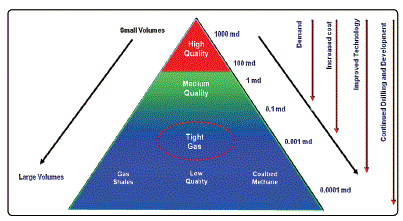
Figure 2. Resource Triangle
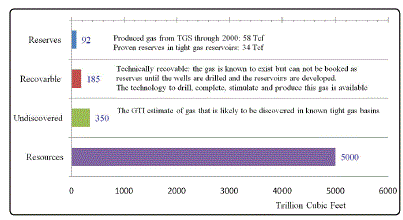
Figure 3. Tight Gas Resources in USA [26]
Using the United States as an analogy, there is good
reason to expect that unconventional gas production will
increase significantly around the world in the coming decades
for the following reasons [3] [6] [10]:
-- Exploitation of the estimated resources
-- A large number of geologic basins around the world
contain unconventional gas reservoirs.
-- Utilization of reasonable recovery efficiency to
develop unconventional gas worldwide.
-- Tight gas sands development in the United States is
critical to future U.S. gas supply and has to be over 4
Tcf/year and is supported by ongoing technological
development.
-- The related developed technology in the United
States over the past 3 to 4 decades will be available
for application around the world.
-- New technology is rapidly becoming a worldwide
commodity through efforts of major service
companies
-- The global need for energy, particularly natural gas, will continue to be an incentive for worldwide
unconventional gas resource development.
-- Tight gas sands, gas shales, and coalbed methane are
already critical to North America today and will be an
important energy source worldwide during the 21st
Century.
-- Unconventional resources exploitation governmental
incentives.
-- Conventional gas is mature and declining so the
future of the gas industry is Unconventional, consequently unconventional gas production has no
other choice but to grow.
-- Higher oil and gas prices are driving the development
of unconventional oil and gas resources.
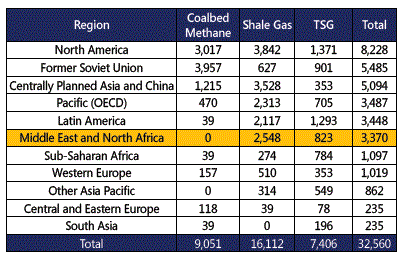
Table 1. Worldwide Unconventional Gas Resources
The petrographic observation of the tight sand porous
media revealed that the pore geometry of sandstone can be
broken down into three categories [6] [12] [13]: 1) grainsupported
pores, 2) narrow intergranular slots connecting
solution pores, and 3) matrix-supported grains.
Basin-Centered Gas Accumulations
The commercial production of gas from BCGAs is
generally associated with areas that have improved
permeability. These areas are known as "sweet spots". Sweet
spots are "those reservoir rocks that are characterized by
porosity and permeability values greater than the average
values for tight gas sands at a specific depth interval" [14]. Holditch [2] reported that "the commercial production from
BCGAs is strongly dependent on the presence of open natural
fractures and the ability to connect these natural fracture
systems through hydraulic fracture stimulation".
Conventional Versus Unconventional
Reservoirs
Many papers in the petroleum literature provide information
on the differences between conventional and low permeability
reservoirs in terms of petrophysical attributes and trapping
mechanisms, most of these papers refer to the materials
published by Naik [15]. These differences lie in the:
-- low-permeability structure itself
-- response to overburden stress
-- impact of the low-permeability structure on effective
permeability relationships under conditions of
multiphase saturation, or
-- understanding of multi-phase, effective permeability
to gas at varying degrees of water saturation under
conditions of overburden stress
A comparison of conventional reservoir behavior with unconventional reservoir behavior is shown in Figure 4 [15] [16]. In a conventional reservoir, it is clear that there is relative permeability in excess of 2% to one or both fluid phases across a wide range of water saturation. In traditional reservoirs, critical water saturation and irreducible water saturation occur at similar water saturation values. Under these conditions, the absence of common water production usually implies that a reservoir system is at, or near, irreducible water saturation. In low-permeability reservoirs, however, one can find that over a wide range of water saturation, there is less than 2% relative permeability to either fluid phase, and critical water saturation and irreducible water saturation occur at very different water saturation values. In these reservoirs, the lack of water production cannot be used to infer irreducible water saturation. In traditional reservoir, there is a wide range of water saturations at which both water and gas can flow. In low-permeability reservoir, there is a broad range of water saturations in which neither gas nor water can flow. In some very low-permeability reservoir, there is virtually no mobile water phase even at very high water saturations. The term 'permeability jail' describes the saturation region across which there is negligible effective permeability to either water or gas. Failure to fully understand these relationships leads to widespread misunderstanding as to how hydrocarbon systems are marked in low-permeability reservoirs.
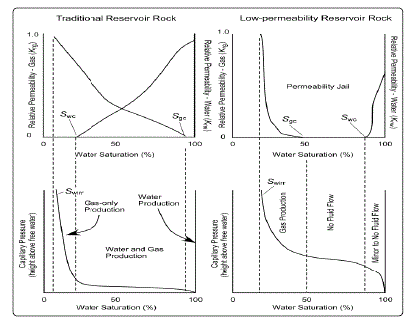
Figure 4. Representation of capillary pressure and relative permeability relationships in traditional and low-permeability reservoir rocks (Swc- Critical water saturation, Sgc -critical gas saturation, and wirr S - irreducible water saturation)
Low-permeability reservoirs are usually characterized
by high to very high capillary pressures at relatively
moderate wetting-phase saturations (Figure 5). In many
cases, wetting-phase saturations of 50% (close to Sgc) are associated with capillary pressures in excess of 1000
psia, suggesting that a large number of pore throats are
less than 0.1 micrometer in diameter and are of the
micro- to nanoscale. In many low-permeability
sandstone reservoirs, wetting-phase saturation continues
to decrease with increasing capillary pressure [6].The relationships between relative permeability, capillary
pressure, and position within a trap in traditional and low
permeability reservoirs are shown in Figures 5 and 6, respectively as represented by map and cross section views
[16]. These two figures illustrate the differences encountered
in drilling a low-permeability reservoir versus a more
traditional one. In both cases, the map shows a reservoir body
that thins and pinches out in a structurally up dip direction. In
conventional reservoirs (Figure 5), water production extends
down dip to a free-water level (FWL). In the middle part of the
reservoir, both gas and water are produced, with water
decreasing up dip. The up dip portion of the reservoir is
characterized by water free production of gas
Figure 6 illustrates relationships found for a reservoir with
low-permeability reservoir properties. In low permeability
reservoirs, significant water production is restricted to very
low structural positions near the FWL. In many cases, the
effective permeability to water is so low that there is little to
no fluid flow at or below the FWL. Above the FWL, a wide
region of little to no fluid flow exists. Farther up dip, waterfree
gas production is found. Because of the wide region with
little to no fluid flow, once drilling encounters the wide
transition zone with virtually no fluid production, drilling
uncommonly extends down dip to a true FWL.
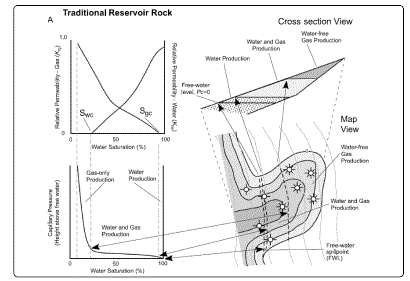
Figure 5. Representation of the relationships between capillary pressure, relative permeability, and position within a trap of a conventional reservoir
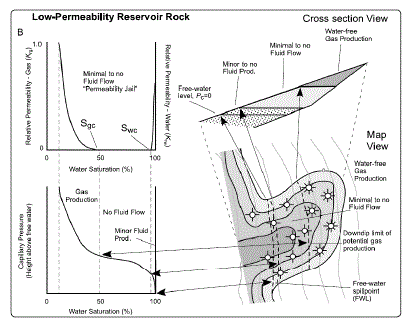
Figure 6. Representation of the relationships between capillary pressure, relative permeability, and position within a trap of a low-permeability reservoir
Challenges
Production from unconventional tight gas reservoirs is
expected to rise in the next decades. Developing the tight gas
sands is a huge challenge to geoscientists faced with
understanding the depositional setting, stratigraphy, structure, geochemistry, geomechanics, seismic character, and
petrophysical properties controlling production. Some of the
greatest challenges include: 1) understanding how and where
these rocks are charged with gas; 2) what controls the location
of highly-productive "sweetspots"; and 3) what factors, such
as sand body size and heterogeneity, account for the large
variations in well drainage areas. To address these challenges
oil and gas industry has to focus on the needed technologies
to continue development of gas from unconventional
reservoirs. Economic production from TGS depends on the
used methods and technologies that address the following
challenges:
-- Geomechanical, petrophysical and geological
characteristics
-- Formation evaluation
-- Reservoir engineering studies (field/well modeling &
simulation)
-- Massive hydraulic-fracturing treatments.
-- Advanced drilling: Horizontal, multilateral and UBD
-- Special completion methods.
Understanding of the geomechanical, petrophysical and
geological properties: formation strength and in-situ stresses; lithofacies associations; facies distribution in-situ porosity; effective gas permeabilities at reservoir conditions; capillary
pressure; pore size and its distribution; etc, is essential for
understanding gas production from TGS reservoirs. Because
most logging tools were developed to evaluate formations
with high porosity, they often lose their sensitivity in lowpermeability, low-porosity reservoirs. If technology can be
developed well enough to provide a better estimate of formation permeability, porosity and water saturation, the
development of unconventional reservoirs can be improved
substantially.
Proper formation evaluation is essential for the
development of TGS reservoir. Not all methods (volumetric, material balance, decline curves and reservoir models) used to
estimate the reserves of conventional reservoirs work to
evaluate the unconventional reservoirs reserves. Usually, volumetric methods do not work in tight gas sands because
the proper drainage area to use in the computation is hardly
ever known. One of the most difficult parameters to evaluate
in tight gas reservoirs is the drainage-area size and shape. In
tight reservoirs, months or years of production normally are
required before the pressure transients are affected by
reservoir boundaries or well-to-well interference. Thus, the
engineer often has to estimate the drainage-area size and
shape for a typical well to estimate reserves. It is required to
know the depositional system and the effects of diagenesis (caused by increased pressure and temperature) on the rock
to estimate the drainage area size and shape for a specific
well. Egg-shaped drainage volumes are likely caused by
depositional or fracture trends and the orientation of hydraulic
fractures. Also, material balance seldom works in tight gas
sands because it is almost impossible to shut in wells long
enough to determine the current average reservoir pressure. Therefore, the best method to determine reserves in tight gas
reservoirs is to analyze production data by use of either
decline curves (production versus time: hyperbolically
decreasing flow rate) or reservoir simulation.
Most TGS reservoirs are not isotropic and homogeneous. Some reservoirs are naturally fractured, layered with
anisotropic permeabilities. The reservoir-engineering analysis
methods must be tailored to better analyze the processes that
occur in TGS reservoirs. A common characteristic of TGS
reservoirs is that the formations can be very thin and/or
several hundreds or even thousands of feet thick. Well
completion cost and recovery maximization can be achieved
if these reservoirs are produced with multizone completions, oriented perforating, massive hydraulic fracturing, and proper
logging methods.
Usually gas production from TGS reservoirs requires some
form of artificial stimulation, such as hydraulic fracturing. Wells completed in tight reservoir rocks have to be stimulated
by one or several hydraulic fracs in order to achieve an
economically adequate production rate. Compared with
conventional reservoirs, TGS often show a much weaker
response to the frac treatments, resulting in low production
rates and a high economic risk. It is known that natural rock
fractures are an important factor in the economic recovery of
gas from tight reservoirs. Advanced methods of gas production
in these environments are taking advantage of gas flow from
natural fractures in the reservoir rock. The distribution, orientation, and density of these fractures is key to proper
planning and well scheduling in tight gas reservoirs. In
addition to these physical attributes, reservoir engineers also
need detailed analyses of the effects of interstitial clays and fluids. The nature of the natural fractures and other
characteristics of the reservoir were sufficiently welldetermined
that drilling could be accurately directed.
Advancements in drilling methods reduce drilling and
field development costs and substantially improve the
economics of developing TGS reservoirs. Further modern
technologies for the production of TGS reservoirs are
horizontal and multilateral wells, as well as underbalanced
drilling. Application of advanced techniques like horizontal
drilling and technologies that permit efficient fracturing of
multiple zones per well allow gas to migrate a shorter distance
to reach a location where it can enter a well and be produced
with minimum driving force. When these reservoirs extend
vertically for several thousand feet, new fracturing techniques
are required. To create better solutions adapted for gas, industry researchers will need to understand underlying flow
physics in greater detail.
Gas production from a TGS well will be low on a per-well
basis compared with gas production from conventional gas
reservoirs. A lot of wells have to be drilled to get most of the
gas out of the ground in TGS reservoirs. Geologists, engineers, log analysts, and other professionals have to come to the
common table with a need to better understand and predict
reservoir properties in low-permeability reservoirs and use
that information in resource evaluation, reservoir
characterization and management.
Case History – Jordan
I.Tight Gas: Risha Gas Field in Eastern Jordan
Jordan has no conventional oil resources of its own and
relies fully on imports. The country's known oil reserves are
only one million barrels and that of natural gas is 213 billion
cubic feet [7]. Production of gas in Jordan began in May 1989
from the Ordovician Formation of Risha gas field that was
discovered in September 1986 (see Figure 7). Initially the
production was from the Northern Area, from the main Risha
area and from the Risha 8 reservoir. Risha basin exploration
began with seismic shooting (9,057 km) and exploratory
drilling by Jordan's Natural Resources Authority. Seismic
images showed horst and graben structures in the Paleozoic
section [18]. The Paleozoic sediments (Figure 8) dip and
thicken eastward while the overlying Mesozoic sediments
thicken toward west and dip under the Basalt Plateau. The
total sedimentary thickness in the Risha basin exceeds 7,000
m [18]. Risha-1 (3177 m TD) and Risha-2 (3314 m) were drilled
in 1984 followed by Risha-3 (4204 m) which discovered gas in
Ordovician sandstones. Since then, dozens of wells have been
drilled; many are dry but some wells produce gas (see figure
7). Reservoir geology of the producing Risha Formation is
quite complex with varying production capacity between
wells due to original poor porosity (2-10%) and permeability (less than 10 md, in most wells less than 0.01 md) locally
improved by natural fracturing and minimum water saturation
of 28%. The Risha field described to be 1500 sq. km in area
produces from Ordovician tight sandstone at different depths
with thin beds (2-12 m each) in faulted glacio-fluvial channels.
Its proven gas reserves are 180 billion cubic feet (Bcf) (equivalent of 34.2 MMbo) [19]. Nevertheless, estimates of
total gas reserves in the field range from 400 bcf [27] to 2-3
Tcf [20]. The decline analysis was used for reserve estimation
in Risha formation with a result of 604 BSCF. However the
estimation represents the minimum recoverable amount of
gas from the existing producers only [20].
Figure 9 shows Jordan natural gas consumption and
production from Risha field [21]. The gas production, from
Risha field, since 1989 and up to the end of 2006 has totaled
0.1598 Tcf (~160 BCF). Current daily production is around 22
MMSCF or 8.03 Bcf per year (0.00803 Tcf/year). The current
yearly production has decreased by about 73% compared to
2006. Six out of 20 producing wells are produced irregularly
through gas compression. Treated gas is sold to Risha power
plant to generate around 70 Mw. The produced gas consists
mainly of methane (91%), carbon dioxide (7.5%) and other
traces (1.5%) with a gross calorific value of 940 Btu/SCF (sales
gas heating value varies from 920 to 980 Btu/SCF). The high
content of carbon dioxide makes the gas sour.
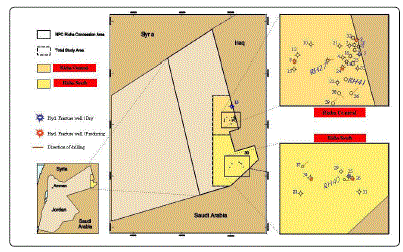
Figure 7. Location of Risha Gas Field in Jordan. NPC Concession [20]
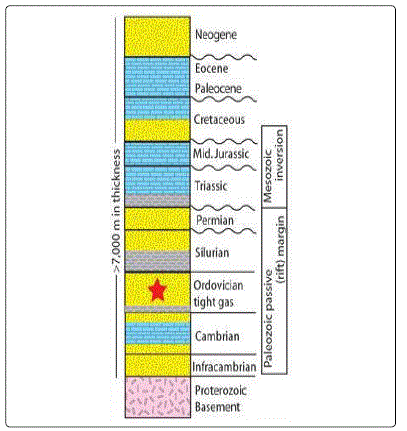
Figure 8. Risha Field Stratigraphic Column
Risha field is widely extended in both areal and vertical
space and there are strong indications about the presence of
large gas potential outside the drainage area of the existing
wells [20], because of the following facts:
-- The majority of the existing producers are
concentrated in relatively small area (30 sq. km) out
of the National Petroleum Company concession area
of 7600 sq. km (Figure 7).
-- The carried out field integrated studies were not
successful due to a huge amount of gas required for
history matching.
-- The petrophysical data in deep wells indicate the
possibility of the presence of huge amount of gas in
deeper Ordovician formations.
-- The tight fractured reservoirs are characterized by
initial sharp decline in rate followed by gradual
leveling off in production with time (Figure 9). Therefore the analytical methods would give
increasing gas volume with time.
-- The experience in Risha, compared to worldwide
observations of analogous reservoirs, indicates that
reservoir pressures near producing wells are close to
their initial values. Thus, drilling more wells will
improve the overall recovery.
-- The importance of Risha field is strengthened by the
fact that it shares a similar geologic history with the
little-developed Akkas gas field, some 200 kilometers
further east in Iraq. Indeed, the Paleozoic section
thickens eastward up to 6,500 m. It appears that the
deserts of eastern Jordan and western Iraq have a
great potential for Paleozoic tight gas plays awaiting
systematic exploration.
-- Proper investment and application of modern
technology for tight sand gas could result in increasing
the production significantly from Risha field.
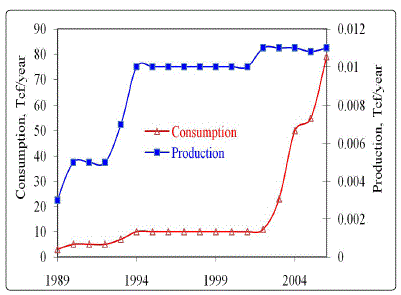
Figure 9. Jordan Natural Gas Consumption and Production from Risha Gas Field
Based on the production history shown in Figure 9, one
can see that during the initial stage of production, gas
productivity grows fast, mainly because more wells were brought in, and kept operating at high reservoir pressure. Risha wells yields gas with the content discussed earlier, and
the reservoir pressure drops a little. The first steady gas
production was reached in 1994 and lasted until the year
2001. In 2000, the NPC in collaboration with Geoquest (a
division of Schlumberger) had conducted a detailed study of
the Risha gas field. Consequently, and during the years 2002-
2005, Weatherford had drilled one well using UBD technology
and re-entered three other wells for production stimulation. This resulting in increasing the gas production and be shifted
to a new steady state (see Figure 9).
Most of the wells drilled after 1986 penetrated only the
Risha member (upper section) of the Dubeidib. The NPC has
set itself an ambitious target to increase gas production from
the field to 300 MMSCFD by 2015. Because the gas production
from Risha field southern area (Figure 7) had begun in August
2003, with few wells drilled so far, and to slow down the
decline in gas production, in October 2009, British Petroleum (BP) signed a deal with the government of Jordan to explore
and develop the natural gas resources of the Risha Basin. During the first phase of the project, BP will explore the area
totaling about 7,000 sq. km along the Jordanian-Iraqi border
for 3-4 years at a cost of $237 million. If the exploration yields
successful results, BP will then invest US$8-10 billion to
produce 300-1,000 million cubic feet (mcf) per day. If all goes
well, the Jordanian government will receive 50% of the
produced gas, with the other half going to BP and NPC. This
will significantly boost Jordan's natural gas and electricity
production.
II-.Shale Gas
The most recent work about shale gas development was
discussed by Khlaifat [22] and the most comprehensive study
about shale gas resources in Jordan was carried out by Luning
et al. [23]. In their study they have identified three lower hot
shale depocenters in Jordan, which are located in the western
Risha, eastern Wadi Sirhan, and Jafr areas. The eastern Risha
area was part of a larger scale paleohigh covering northeast
Jordan, most of Syria and Iraq, and north-central Saudi Arabia (Qusaiba area). At least in Jordan, the high coincides with the
depocenter of the latest Ordovician glaciation.
Thermal maturity increases from immature in the Southern
Desert outcrops to late or postmature in northern Jordan. Organic richness and pyrolysis data decline significantly with
increasing thermal maturity caused by hydrocarbon
generation. Prior to maturation, maximum organic richness
was interpreted to have considerably exceeded 10% (TOC) with good S2 yields (up to 74 mg/g) as reflected in the values
of the immature lower hot shale in two exploration wells in
the Jafr and Southern Desert areas [23]. Konert et al. [24]
estimated that Silurian sourced hydrocarbons in the range of
about 1 trillion bbl of oil equivalent were initially reservoired
on the Arabian plate. The oil and gas discoveries in the Risha
and Wadi Sirhan areas demonstrate the existence of the
Silurian hydrocarbon system in Jordan, however, with little
exploration success so far. This may partly be caused by the
low level of exploration in Jordan [25]. For further exploration of shale gas in Jordan, more efforts have to be put towards
carrying out a proper workflow for Silurian plays shale gas
resource development where Ordovician reservoir quality and
timing of maturation are not overlooked.
Conclusion
The following conclusions can be drawn from the paper: -- There is an enormous volume of unconventional gas
to supply world energy needs for many decades to
come to be found and produced.
-- Although TGS production is growing in more than 35
countries, gas production from a TGS well is low
compared with gas production from conventional
reservoirs on a per-well basis.
-- A bundle of wells have to be drilled to get most of the
gas out of the unconventional reservoirs.
-- Small well spacing is required to deplete a lowpermeability
reservoir in a 20- to 30-year time frame.
-- The capital cost of unconventional gas production is
high because of the need for more rigs, equipment
and people.
-- The driving forces to bring much of unconventional
TGS to market are: increased oil and gas prices; decline in conventional oil and gas production; and
improvement in drilling, completion and hydraulic
fracturing technologies.
-- Understanding and predicting reservoir properties, needed for resource evaluation, reservoir
characterization and management, in lowpermeability
reservoirs requires a team work of
geoscientists, engineers and other professionals.
-- The three considered cases show that tight and shale
gas reservoirs have a huge future potential for
production.
References
- IEA (International Energy Agency) Report, 2005.
- Holditch S, Tight Gas Sands. JPT. 2006; 86-93.
- Holditch S, Perry K, Lee J. Unconventional Gas Reservoirs – Tight Gas, Coal Seams, and Shales. Working Document of the National Petroleum Council on Global Oil and Gas Study. 2007.
- Law BE, Curtis JB. Introduction to Unconventional Petroleum Systems. AAPG Bulletin. 2002; 86(11): 1851-852.
- Khlaifat A, Qutob H, Unconventional Tight Gas Reservoirs – Future Energy Source. Materials in Jordan, Amman, Jordan, 2010.
- Khlaifat A. Two Phase Flow through Low Permeability Fractured Tight Sand Porous Media, PhD thesis, Illinois Institute of Technology, Chicago, USA, 1998.
- DGMK German Society for Petroleum and Coal Science and Technology. 2010.
- International Energy Outlook 2016.
- Masters JA. Deep Basin Gas Trap, Western Canada. AAPG Bulletin. 1979; 63(2): 152-181.
- Rogner HH. An Assessment of World Hydrocarbon Resources, IIASA, WP-96–26, Laxenburg, Austria, 1996.
- Kawata Y, Fujita K. Some Prediction of Possible Unconventional Hydrocarbon Availability Until 2100. SPE Paper 68755, SPE Asia Pacific Oil and Gas Conference, Jakarta, 17-19 April, 2007.
- Soeder DJ. Reservoir Properties and the Pore Structure of Tight Gas Sands. AAPG Bulletin. 1984; 68(4): 530.
- Soeder DJ, Randolph PL. Porosity, Permeability, and Pore Structure of the Tight Mesa Verde Sandstone, Piceance Bacin, CO. SPE, 1984.
- Surdam RC. Wyoming and the 21st Century: The Age of Natural Gas," Proceedings of a Workshop on the Future of Natural Gas in Wyoming, Laramie, Wyoming, Institute for Energy Research, 1995.
- Naik GC. Tight Gas Reservoirs – An Unconventional Natural Energy Source for the Future," August 23rd 2010.
- Shanley, Keith W, Robert MC, John WR. Factors controlling prolific gas production from low-permeability sandstone reservoirs: Implications for resource assessment, prospect development, and risk analysis. AAPG Bulletin. 2004; 88(8): 1083-1121.
- Oil & Gas Journal, 21 December 2009.
- Rasoul SP. Paleozoic Tight Gas Plays in Jordan. Geo ExPro Magazine. 2010; 7(1).
- Oil and Gas Journal, 2 July 2007.
- NPC Webpage, cited August 3rd 2010.
- United States Energy Information Administration, August 3, 2010.
- Khlaifat A. Shale Gas: How it can Targeted? International Conference on Oil, Gas and Petrochemistry, Dubai, April 3-5, 2017.
- Luning S, Shahin YM, Loydell D, Al-Rabi HT, Masri A, Tarawneh B, Kolonic S. Anatomy of a World-Class Source Rock: Distribution and Depositional Model of Silurian Organic-Rich Shales in Jordan and Implications for Hydrocarbon Potential. AAPG Bulletin. 2005; 89(10): 1397-1427. doi: 10.1306/05250505014
- Konert G, Afifi AM, Al-Hajri SA, de Groot K, Al Naim AA, Droste HJ. Paleozoic stratigraphy and hydrocarbon habitat of the Arabian plate: AAPG Memoir. 2001; 483–515.
- Beydoun ZR, Futyan ARI, Jawzi AH. Jordan revisited: Hydrocarbons habitat and potential. Journal of Petroleum Geology. 1994; 17(2): 177– 194. doi: 10.1111/j.1747-5457.1994.tb00125.
- GTI E&P Services, Tight Gas Resources Map of the United States. GTI E&P Services, Houston, 2001.
- Jordan Times, 12 March 2000.
- Law BE. Basin Centered Gas Systems. AAPG. 2002; 86: 1891-919.

